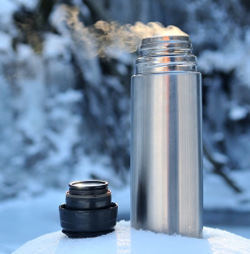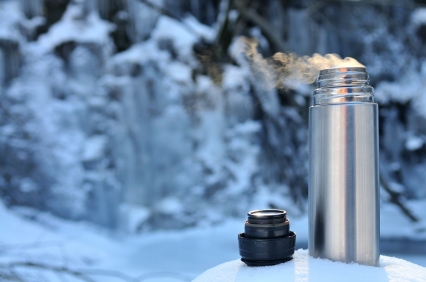Photonic Thermos
The pure vacuum of a thermos is not the best possible insulator for keeping your soup warm. Last year a team found theoretically that a structure known as a photonic crystal could block heat flow even more effectively than vacuum. In the October Physical Review B they present a complete theory explaining the phenomenon and reveal that the structure’s insulating ability is surprisingly independent of its structural details. Their work suggests that photonic crystals, which have promising applications in communications and computing, might one day be used for their thermal properties, perhaps in devices that turn the sun’s heat into usable energy.
Hot soup in a thermos is surrounded by a vacuum between the inner and outer walls, which prevents heat from conducting directly through the sides, as it would if the walls were a one-piece solid. But the soup still loses heat by “glowing” in infrared light because the light radiated through the walls takes energy away with it.
Shanhui Fan of Stanford University in California and his colleagues wondered if photonic crystals–periodic structures famous for blocking narrow frequency ranges of light–could block the broad range of infrared frequencies radiated by a warm body. Last year they studied a stack of alternating silicon and vacuum layers theoretically, calculating the thermal conductance–the ease with which infrared photons could pass through. The team evaluated different layer-thicknesses, numbers of layers, and temperatures and showed that for a 100-micron-thick stack containing 10 one-micron-thick silicon layers, at room temperature and above, the thermal conductance plunged to about half that of a vacuum [1]. So soup in a photonic crystal thermos would stay hot longer than in a normal thermos.
In their new paper, the team undertakes a complete theoretical analysis of the problem, rather than solving specific cases. Photonic crystal theorists usually calculate the narrow ranges of frequency blocked by the structure, the so-called band gaps. But given the very large number of gaps over the wide range of thermal radiation, Fan and his colleagues used a different approach, which they call a statistical theory. They calculated the fraction of all frequencies that the photonic crystal allows through. They found that this fraction, and therefore the thermal conductance, doesn’t depend on the thickness of the individual layers but only on how fast light travels in the solid layers–the solid’s index of refraction. This result was unusual, says Fan. “Normally, for a photonic crystal, for other applications, the detail of the structure is very important.” But with such a large swath of frequency, structure-induced increases or decreases in the sizes of the many band gaps appear to largely cancel out and leave the transmitted fraction unchanged.
Steven Johnson of the Massachusetts Institute of Technology says the results suggest researchers have less control than they thought. “The conductance is mainly determined by the available materials and not by the layer geometry,” so researchers have fewer ways of fine-tuning the conductance.
The team plans to study photonic crystals with irregular structures, which they think could be even better insulators. Fan says that controlling heat flow with photonic crystals could be useful for researchers trying to capture the sun’s heat as an energy source. “The issue of allowing optical radiation to pass through while keeping heat within is very important for solar-thermal applications,” he says.
–Lauren Schenkman
Lauren Schenkman is a science writing intern at the American Physical Society.
References
- W. T. Lau, J.-T. Shen, G. Veronis, S. Fan, and P. V. Braun, “Tuning Coherent Radiative Thermal Conductance in Multilayer Photonic Crystals,” Appl. Phys. Lett. 92, 103106 (2008)
More Information
more on photonic crystals from MIT Fan research group at Stanford University





